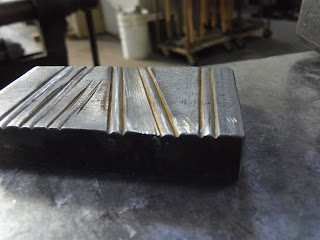Obviously, the months following my return from England were filled with exploration and excitement, testing the limits of what I had learned, and discovering a hundred new doors too be knocked upon. It's always true that the more you learn, the more you realize you have far more to learn, and it's apparent to me every day, using my hands and mind at the same time. Sometimes that can be intimidating, but it's comforting to know beyond any doubt that you'll never run out of things to learn. There's just too much.
Well, I heat treated, ground, and polished what I had for blades. The san-mai seax turned out alright; here it is on my sanding setup, un-etched, with the contrast visible in the reflecting light.
A very new experiment came in the form of this large, almost bowie-style knife made of 1084. I made this one to see if I could figure out how to forge a knife with an integral bolster, which I partially achieved. It was, in my opinion, much to thin to count as a real bolster, but I became familiar with filing techniques and where I needed to hammer to make the bolster.
However, the most interesting experiment this knife posed was the Japanese-style differential hardening. The aesthetic/visual effect is called hamon, and is used to describe the visible line on the blade between the hard edge and the soft spine. Before the blade is hardened in the quench, the spine is covered with clay, effectively insulating it and keeping the heat in as the blade cools down in the quench. The slow cooling of the insulated spine is different from the rapid cooling of the edge, resulting in different steel crystal shapes on the molecular level. That means a hard edge, soft spine, barely perceptible transition, but defined differentiation. I'll definitely be making use of this technique in the future!
Honestly, the below is a picture of some of Jim Austin's smelting alchemy that I do not understand whatsoever.
I could, however, understand the chisel he made for a double groove with a raised middle. He made it for embellishing the soft mild-steel bodies of his peerless viking axes. I tried it out on the trial piece. Guess which grooves are mine! [It's really truly actually the two on the right]
These were warm days filled with sun and sweat and excitement. I shared many hours in daylight and in dark with Jim, Jeff, Nate Smith, Nina Heckman, Ryan Burkhart, Dan Hopper, and Anna Geyer with sun and stars above us and hard work and good fun around us. Oakland how I do miss ye.





Come on back when ye can.
ReplyDelete